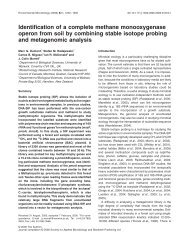Conservation of the vaquita Phocoena sinus - The Department of ...
Conservation of the vaquita Phocoena sinus - The Department of ...
Conservation of the vaquita Phocoena sinus - The Department of ...
Create successful ePaper yourself
Turn your PDF publications into a flip-book with our unique Google optimized e-Paper software.
206 L. Rojas-Bracho, R. R. Reeves and A. Jaramillo-Legorreta<br />
Scientific and political-technical obstacles<br />
Although it seems inconceivable, <strong>the</strong> governors <strong>of</strong> Sonora and Baja California, <strong>the</strong> two states<br />
bordering <strong>the</strong> <strong>vaquita</strong>’s range in <strong>the</strong> nor<strong>the</strong>rn Gulf <strong>of</strong> California, have cast doubt on <strong>the</strong><br />
<strong>vaquita</strong>’s existence. According to a news article, <strong>the</strong> governor <strong>of</strong> Sonora said that ‘nobody<br />
wants to wipe out shrimp or <strong>the</strong> <strong>vaquita</strong>, if indeed it exists’ (‘expuso . . . que nadie quiere<br />
acabar ni con los camarones ni con la <strong>vaquita</strong> marina “si es que existe” ’). Various <strong>of</strong>ficials<br />
in state fisheries agencies, members <strong>of</strong> <strong>the</strong> Fisheries Chamber <strong>of</strong> Commerce, representatives<br />
<strong>of</strong> fishing cooperatives, and even university researchers receiving contracts from <strong>the</strong> fisheries<br />
sector, have made similar declarations doubting or denying <strong>the</strong> <strong>vaquita</strong>’s existence. Needless<br />
to say, attempting to gain support for a recovery strategy on behalf <strong>of</strong> a ‘non-existent’ species<br />
would be a futile task. However, thanks to <strong>the</strong> positive results <strong>of</strong> a photographic expedition<br />
to obtain <strong>vaquita</strong> images (well publicized in <strong>the</strong> media) and as a result <strong>of</strong> intensive discussions<br />
and negotiations, this issue has largely been set aside. Mexican <strong>of</strong>ficials have accepted that<br />
<strong>the</strong> <strong>vaquita</strong> does exist, although many remain unwilling to acknowledge its critically endangered<br />
status.<br />
Ano<strong>the</strong>r obstacle has been <strong>the</strong> refusal by state government <strong>of</strong>ficials, as well as some<br />
federal fishery <strong>of</strong>ficers, to credit <strong>the</strong> scientific evidence indicating that immediate action is<br />
needed to reduce <strong>the</strong> <strong>vaquita</strong> by-catch. In recent meetings, representatives <strong>of</strong> Sonora and<br />
Baja California have rejected <strong>the</strong> scientific consensus – that <strong>the</strong> <strong>vaquita</strong> population is very<br />
small and declining and that by-catch in gill nets is <strong>the</strong> main risk factor. This has been in<br />
spite <strong>of</strong> repeated expressions <strong>of</strong> that consensus in letters and published statements by<br />
scientific bodies such as <strong>the</strong> American Society <strong>of</strong> Mammalogists, <strong>the</strong> Society for Marine<br />
Mammalogy, <strong>the</strong> European Cetacean Society, <strong>the</strong> Latin American Society for Aquatic<br />
Mammals, <strong>the</strong> Scientific Committee <strong>of</strong> <strong>the</strong> International Whaling Commission, and <strong>the</strong><br />
IUCN Cetacean Specialist Group. Counterarguments by government and fishery representatives<br />
have generally hinged on three main points, as follows: (i) <strong>the</strong> best current estimate<br />
<strong>of</strong> population size (Jaramillo-Legorreta et al., 1999) is outdated as <strong>the</strong> survey was conducted<br />
almost a decade ago (1997); (ii) <strong>the</strong> bycatch estimate (D’Agrosa et al., 2000) is even<br />
more out <strong>of</strong> date (1995); and (iii) <strong>the</strong>re is no direct evidence <strong>of</strong> population decline and<br />
<strong>the</strong>refore <strong>the</strong> <strong>vaquita</strong> population could be stable or even increasing. In <strong>the</strong> absence <strong>of</strong><br />
unequivocal pro<strong>of</strong> that <strong>the</strong> population is declining towards extinction, decision-makers and<br />
representatives <strong>of</strong> fishing interests are unwilling to support conservation actions that would<br />
be unpopular in <strong>the</strong>ir constituencies. <strong>The</strong> <strong>vaquita</strong> is a classic example <strong>of</strong> situations in<br />
which ‘<strong>the</strong> political costs <strong>of</strong> more surveys and more planning meetings are slight compared<br />
with those <strong>of</strong> actions affecting employment and short-term human welfare’ (Reeves &<br />
Reijnders, 2002).<br />
<strong>The</strong> points raised by <strong>the</strong> politicians and industry advocates lead to <strong>the</strong> following key<br />
questions:<br />
1. Would a new <strong>vaquita</strong> abundance estimate tell us whe<strong>the</strong>r <strong>the</strong> population is declining?<br />
2. How <strong>of</strong>ten must new estimates or indices be obtained to adequately monitor trends in <strong>the</strong><br />
<strong>vaquita</strong> population?<br />
3. Is a new bycatch estimate required to determine whe<strong>the</strong>r fishing restrictions are necessary?<br />
<strong>The</strong>se kinds <strong>of</strong> questions are certainly not unique to <strong>the</strong> <strong>vaquita</strong>. In fact, <strong>the</strong> dilemma <strong>of</strong><br />
how much and how conclusive <strong>the</strong> evidence needs to be before taking remedial action is at<br />
<strong>the</strong> heart <strong>of</strong> <strong>the</strong> much-maligned but still vital (in our view) ‘precautionary principle’ (see, e.g.<br />
Mangel et al., 1996; Meffe, Perrin & Dayton, 1999). As more frequent and more precise<br />
estimates <strong>of</strong> key parameters are sought, <strong>the</strong> critically endangered species becomes more rare<br />
and vulnerable to extinction.<br />
© 2006 <strong>The</strong> Authors. Issue compilation © 2006 Mammal Society, Mammal Review, 36, 179–216




